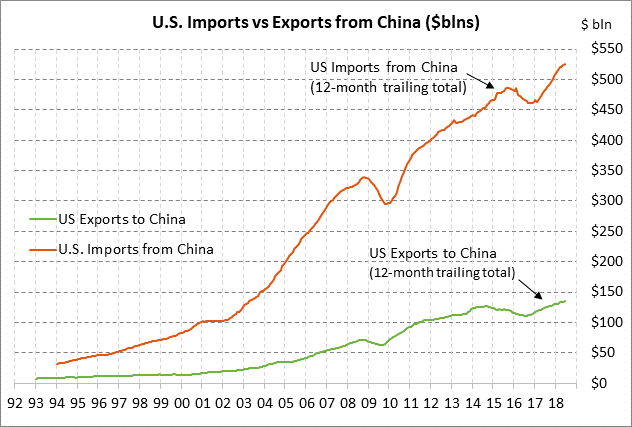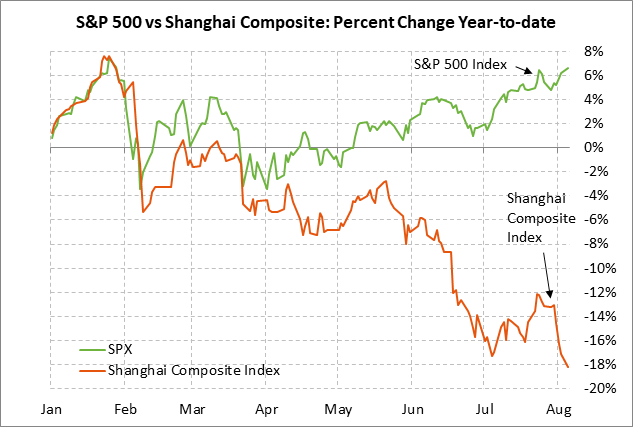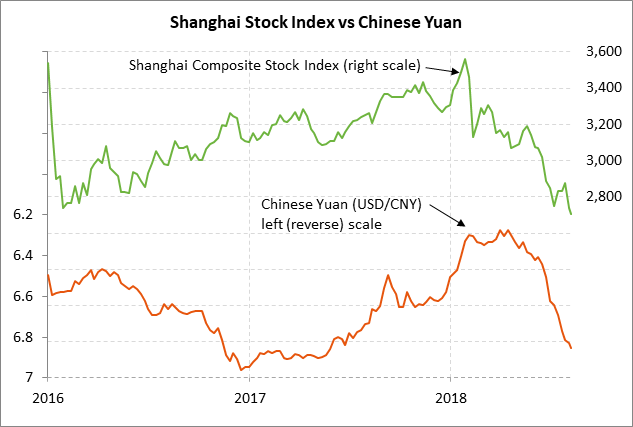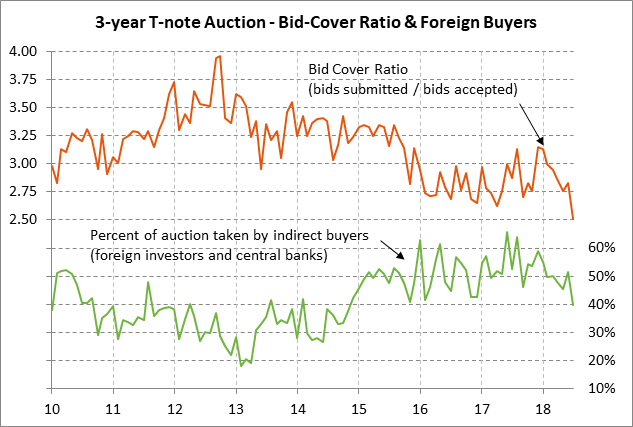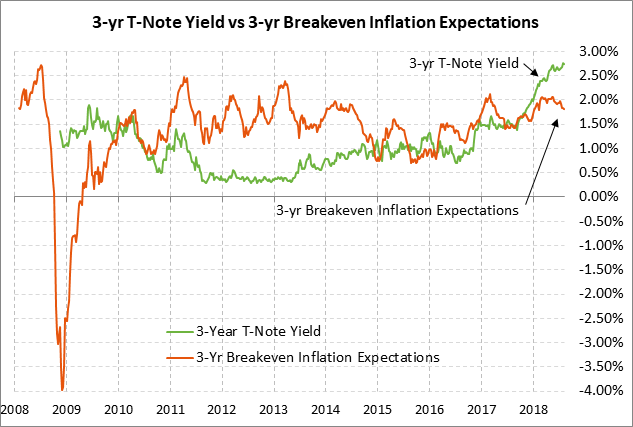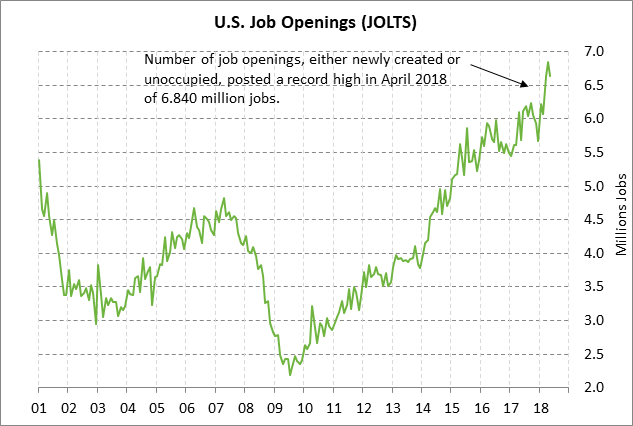- No sign of a US/Chinese trade cease fire yet
- 3-year T-note auction expected to yield near 2.74%
- U.S. JOLTS job openings expected to remain strong
No sign of a US/Chinese trade cease fire yet — President Trump over the weekend said that China “is talking to” Washington about trade, but it remains unclear how serious those talks are. The Trump administration has yet to implement the 25% tariff on $16 billion of Chinese goods, which is otherwise ready to go, suggesting that the Trump administration may be testing the waters to see if China is interested in offering concessions to defer that tariff. The Trump administration’s threat of a 25% tariff on another $200 billion of Chinese goods cannot go into effect until after the public comment period ends on September 5, which means there is still a month to go before the Trump administration can drop that big hammer.
The Trump administration appears determined to go to the mat on getting what it wants out of China, even if U.S. farmers and businesses and the U.S. stock market need to be sacrificed over the short to medium term. Indeed, President Trump seems likely to proceed with his threat to slap a tariff on all of U.S. imports from China, and even increasing the size of the tariff, until China finally cries uncle and agrees to most of the concessions that the U.S. is demanding.
President Trump seems confident that his trade approach is working. Over the weekend, he said that “Tariffs are working far better than anyone anticipated” and that playing hardball on trade is “my thing.” He added that the Europeans were “dying to make a deal,” which followed his threat to slap a 20% tariff on imports of European autos.
President Trump is also clearly using the stock market as a measuring stick for which side is winning the trade war. Mr. Trump noted over the weekend that China’s stocks have “dropped 27% in the last 4 months, and they are talking to us.” It is not clear exactly what measure Mr. Trump was talking about, but the Shanghai Composite index has so far corrected lower by a total of -25% from January’s 2-1/2 year high, putting it into bear territory.
The S&P 500 index, by contrast, took a heavy hit in February on the Trump administration’s announcement of tariffs but has now reversed almost all of those losses. Moreover, the Nasdaq 100 index has rallied to new record highs, giving Mr. Trump the idea that the divergence in U.S. and Chinese stocks shows that the U.S. is winning the trade war.
Meanwhile, China has already agreed to reduce its trade surplus with the U.S. by buying more U.S. products such as soybeans and LNG. However, China appears unwilling to bargain away its “Made in China 2025” plan to climb the manufacturing ladder in coming decades to produce higher tech products and subsidize those industries where needed. China believes that the Trump administration is using trade complaints to mask its real goal of holding China’s economy back so that China doesn’t become a bigger superpower than the U.S. in coming decades.
China says that it is preparing for a drawn-out trade war since it doesn’t seem willing to go nearly as far as the Trump administration is demanding on trade concessions. China can afford to take a long-term view in its relationship with the U.S. since President Xi is essentially president for life, whereas President Trump could end up being a single-term president or perhaps even less. China could choose to simply absorb the short-term pain and wait out President Trump, looking forward to dealing with the next U.S. president, who is unlikely to be nearly as demanding on trade as President Trump.
In our view, the best that the markets can hope for at this point is a tariff cease-fire agreement similar to the recent US/EU agreement. Europe did not have to give up much to convince President Trump to agree to a cease fire. The Trump administration plans to drive a much harder bargain with China than Europe, but there is nevertheless at least a model now whereby the two sides could take a time-out for negotiations and Mr. Trump could declare victory to his base.
3-year T-note auction expected to yield near 2.74% — The Treasury today will sell $34 billion of 3-year T-notes. The Treasury will then continue this week’s $78 billion Treasury refunding operation (which is $5 billion larger than May’s refunding) by selling $26 billion of 10-year T-notes on Wednesday and $18 billion of 30-year bonds on Thursday. Today’s 3-year T-note issue was trading at 2.74% in when-issued trading late yesterday afternoon, which is only 5 below last week’s 10-3/4 year high of 2.79%.
The 12-auction averages for the 3-year are: 2.88 bid cover ratio, $70 million in non-competitive bids to mostly retail investors, 4.1 bp tail to the median yield, 28.2 bp tail to the low yield, and 58% taken at the high yield. The 3-year is the second least popular security among foreign investors and central banks. Indirect bidders, a proxy for foreign buyers, have taken an average of only 51.3% of the last twelve 3-year T-notes, which is well below the median of 63.3% for all recent Treasury coupon auctions.
U.S. JOLTS job openings expected to remain strong — The market consensus is for today’s June JOLTS U.S. job openings report to show a small -13,000 decline to 6.625 million. The JOLTs series has been very volatile in recent months but is only -202,000 below April’s upward spike to a record high of 6.840 million jobs. The continued high level of the JOLTS job openings series is a positive leading indicator for the payroll report since many job openings will turn into an actual job hire within 1-3 months when the hiring process is complete.

